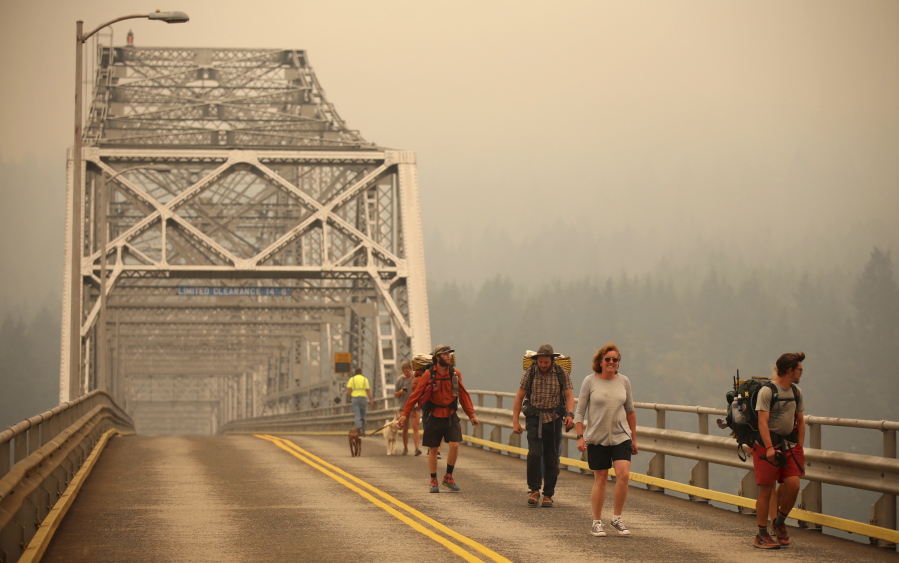Raging wildfires, forest closings, unhealthy air warnings and more have made it a tough week for Clark County outdoors enthusiasts. Hikers, hunters, fishermen, mushroom hunters and berry gatherers are among those stymied by the Eagle Creek Fire currently burning in the Columbia River Gorge.
Fishermen were already struggling because of poor returns of salmon and steelhead. The river closures and poor air quality have kept many of them off the water.
“The Coast Guard closed the Columbia between Reed Island and Bonneville Dam, and this is the peak for that section of the river,” said Jimmy Watts, a fish biologist for the state of Oregon. “Those guys that usually fish there are having to find a new spot.”
However, fall rains should put anglers back on track for late fall.
The smoke has also kept many hunters out of the field, although the fires should regenerate growth, especially of alder and early successional shrubs that provide food for deer and elk. However, for now conditions are tough, and large parts of the forest have been closed because of fire danger.
Perhaps the outdoor recreationists that are suffering the most are the region’s hikers. Many favorite trails are closed because of the fire, and it is unknown when they will reopen. Stan Hinatsu, the Recreation Manager for the Columbia River Gorge National Scenic Area, warns that many trails may be off-limits for some time.
“It could be a long closure. The understory has burned away, releasing rolling rocks and snags,” said Hinatsu. “It’s too early to tell the impact on recreation. It’s mostly a mosaic burn, but we don’t know where it was a high intensity or low intensity burn. We won’t know the impact on the trails until we can get an assessment.”
That could take a while. The assessment teams will not go into any areas until the risks from the fire are reduced.
People that regularly hike the Gorge are anxious and apprehensive, not knowing what they will find when the affected trails reopen. One of those hikers is Ryan Ojerio, the Southwest Regional Manager of the Washington Trails Association.
“I’m hopeful it did not burn hot everywhere, so I’m hoping I’ll be pleasantly surprised,” he said. “I have seen photos of the Angel’s Rest area, and it completely changed that landscape.”
Ojerio has hiked through other badly burned areas. He says recovery depends on how hot the fire was. If it is a mosaic fire the recovery could be fairly quick. However, in heavily burned areas it will take years just to start the process of rejuvenation.
“The forest may be changed drastically, and people may be saddened when they see it,” he said. “Hopefully some areas were spared. Recovery in some places may be beyond my lifetime.”
Fire is part of the Northwest forest landscape, and that is how these forests rejuvenate themselves. If a forest is primed for a fire, anything can start it. Lightening strikes, campfires, or any other source of spark can set them off.
However, this fire did not start that way, as teenagers are suspected of starting the blaze with fireworks. That bothers Laura Kok, a physician’s assistant in Vancouver. She has hiked trails in the Columbia River Gorge for many years, and is frustrated that she can’t get back in to hike. She is used to fires, but this one hurts a little more than usual.
“This one is different. Everything’s burning, everything’s smoky. It’s huge,” she said. “And it’s so unnecessary. I do hope these kids feel a sense of responsibility. I feel an overwhelming sense of frustration.”
While the fire, and its affects on the outdoorsmen can seem unbelievably gut-wrenching, the truth is that the forests will recover, and be even healthier in the long run. Still, it will be hard to bear when hikers can get back in, and see what has happened to the trails they have loved for so long.
It may be a long road to recovery since many trails will need extensive repairs. And, recovery will not start until fall rains quench the fires. That is when the real work will begin.
The fire’s impacts
The Eagle Creek fire was allegedly started by a group of teenagers setting off fireworks on Sept. 2. The fire has burned over 33,000 acres and is about 7 percent contained. The blaze jumped the Columbia River and started the Archer Mountain fire on the Washington side of the Gorge.
Listed here are some of the closures and health warnings that are a direct consequence of the Eagle Creek Fire:
• Interstate 84 remains closed in both directions. While the westbound lanes may open soon, the east boundlanes will remain closed for some time in order to remove debris from the road. Popular fisheries at the mouth of Eagle Creek and Tanner Creek are inaccessible to bank anglers.
• The Historic Columbia River Highway is closed and will remain so indefinitely as fire crews work to remove debris and hazard trees.
• Unhealthy air advisories have been issued repeatedly because of the thick smoke. People were asked to remain indoors and to avoid any exercise outdoors.
• All trails on the Oregon side of the Gorge remain closed indefinitely.
• The Columbia River was closed to boat traffic from Reed Island to Bonneville Dam for over a week. The closure was lifted at 6 p.m. Sunday.
• Hood River County public forest lands, trails, and roads were closed, and remain so, for all activities because of fire threats.
• Fish counts at Bonneville Dam were suspended, leaving fisheries managers in doubt as to how many salmon and steelhead are actually crossing the dam.



